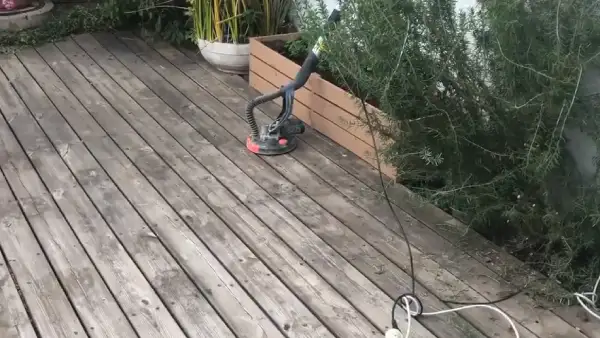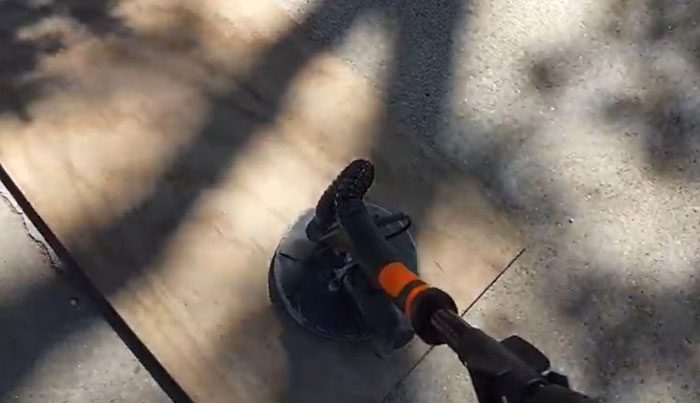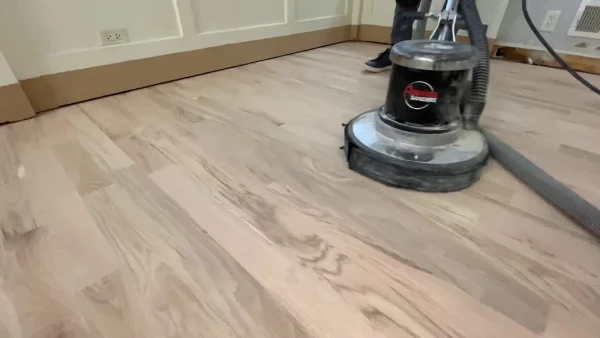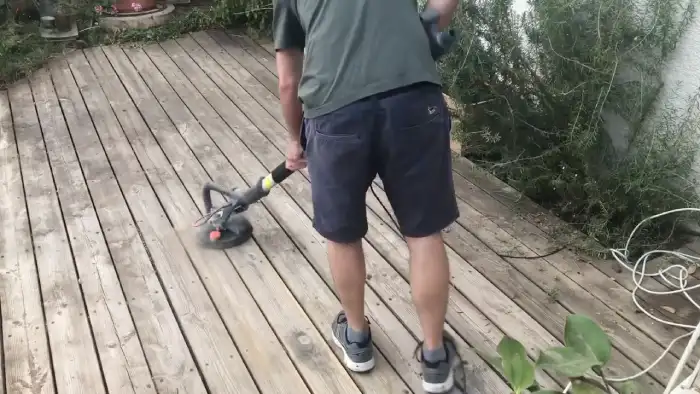Last Updated on March 18, 2023
If your wood floor is looking a bit worse for wear, don’t be disheartened, there’s an easy solution. A drywall sander can provide the perfect amount of tenderness and love to get your tired-looking wood back to life. This simple tool is incredibly easy to use and cost-effective, saving you time and money.
But don’t get too carried away. Start by adequately preparing the area and setting up the machine correctly to ensure everything goes as planned. With careful handling of this amazing tool, achieving that gorgeous new look will be effortless.
Here, we’ll walk you through the preparation, setup, and implementation process so that, soon enough, you can uncover your beautiful hardwoods. Let’s begin this exciting transformation.
How Can You Use a Drywall Sander on Wood Floors: In Easy Steps
If you are planning to sand your wood floors with a drywall sander, there are certain steps and precautions you should take. Although this is not the most commonly used method of sanding wood floors, it can still be an effective way to get a smooth result and save you time.

Step 01: Prepare the Floor
Before using a drywall sander on wood floors, it is crucial to prepare the floor properly.
The first step is to clear the room of furniture and other objects. This will make it easier to move around and sand the entire surface without obstruction. It is also important to sweep or vacuum the floor to remove loose debris, such as sawdust and dirt, that may otherwise interfere with the sanding process.
Furthermore, for your own safety, be sure to wear a dust mask, safety goggles, and ear protection before beginning work. Also, patch any holes in the wood with putty and sand them down using fine-grit sandpaper.
Finally, you should use an appropriate cleaning product to ensure that all remaining dust from patching is removed from the floor before proceeding further.

Step 02: Set Up The Drywall Sander
Once you have prepared the floor properly, you can begin setting up your drywall sander for use on wood floors. To do this safely and correctly, it is important to assemble your drywall sander according to manufacturer guidelines.
Ensure that all connections are securely fastened before starting work; this will help minimize vibration while operating the machine. And select an appropriate grit for sanding wood floors (typically 80-grit).
Finally, attach a vacuum hose to capture dust while working. This will help keep your work area clean and safe from respiratory hazards.
Step 03: Begin Sanding The Floor With The Drywall Sander
When sanding a wood floor with a drywall sander, never move the drywall sander in straight lines, as this can scratch the wood. Instead, it should be used in a circular or oscillating motion.
Furthermore, it is essential not to put too much pressure on the sides of the disc. This can cause indentations or gouges in the floorboards that may be difficult or impossible to fix. It is also important to overlap each sanding pass slightly to achieve an even finish afterward.
Finally, it is advisable to stop periodically throughout the project and change out discs as needed to ensure that progress is being made. Taking these precautions will help ensure that your efforts are successful and your floor looks great after refinishing.
Step 04: Finish Up & Clean Up After Your Work Is Done
Once you have finished sanding the wood floors, there are still some steps you need to take before the job is done.
Check over the entire area one last time for any missed spots or imperfections and resend these areas if necessary. Then use a vacuum cleaner to remove any remaining dust from the project site before applying a protective polyurethane coating which will seal all your hard work.
After completing this step, you should evaluate the appearance of your newly refinished floors and see if anything needs further attention or fixing before declaring your work complete.
Ensure you properly dispose of any waste produced during home renovations, such as old rags, sawdust, and packaging materials, so that they do not pose a hazard or create an eyesore around your home.
Following these steps will ensure that your floor looks great and lasts for a long time.
What Kind of Drywall Sander to Use on Hardwood Floors?

The best drywall sander for hardwood floors is a drum sander or random-orbit sander, specifically designed for sanding wood surfaces. Drum sanders provide a more aggressive, deep sanding action than other sanders and are ideal for removing heavy material such as old paint or varnish.
A random-orbit sander is great for getting in the small nooks and crannies that may be inaccessible to larger machines, and it provides a smoother final finish.
It’s important to note that both types of sanders require specialized knowledge and skill to use correctly, so it is recommended to consult with an expert before attempting this job.
Check out these drywall sander suggestions for hardwood floors:
Drywall Sander with Vacuum Attachment
This drywall sander is the perfect tool for any refinishing project, offering an efficient and dust-free sanding experience. It features a powerful motor and variable speed settings that allow you to choose the best setting to suit your needs. The vacuum attachment helps maintain a clean work area and allows for quick cleanup after the job is done.
Drywall Refinishing Sander with Dust Collector
This drywall sander provides professional-grade performance for heavy-duty jobs, making it ideal for larger projects like ceilings or walls. It comes complete with a dust collector, which makes it easy to keep your workspace tidy while you work.
The variable speed controls allow you to select the best setting for each job, and its ergonomic design ensures that it is comfortable to use during extended periods of sanding.
7 Variable Speed Electric Drywall Sander
This electric drywall sander offers precise control when sanding drywall surfaces, making it ideal for achieving even results in a short amount of time.

Its seven variable speed settings let you adjust the power level depending on the job, while its ergonomic design keeps user fatigue at bay during long projects. It also has an extra-long cord that gives you plenty of reach in any room of your house or commercial space.
Electric Drywall Sander with 5 PCS Sanding Discs
This electric sander delivers all the power needed to get smooth results quickly, no matter what size project you’re tackling. It contains five types of sanding discs for tackling rough surfaces and fine finishes, while an adjustable suction system ensures that dust is collected efficiently.
Plus, its comfortable handle and lightweight build make this unit ideal for lengthy tasks without causing fatigue in users’ hands or arms.
Can a Drywall Sander Be Used On a Wood Deck?

Yes, using a drywall sander on a wood deck can be done safely if done correctly by following all safety precautions. These include wearing appropriate protective gear such as goggles, gloves, dust masks, and earplugs. Using the right type of sandpaper, working in well-ventilated areas, and ensuring the power cord is secure throughout the process.
Also, since most drywall sanders can not reach every nook and cranny of wooden decks, it may be necessary to use additional tools, such as an orbital sander or hand plane, for those areas that are difficult to access with the drywall sander.
Can You Sand a Hardwood Floor with an Orbital Drywall Sander?
Yes, an orbital drywall sander can be used safely to sand hardwood floors as long as all safety guidelines are followed.
Protect yourself and your workspace before starting the job with safety goggles, masks, gloves, and earplugs. Make sure you have proper ventilation too. Pick out sandpaper of the right grade and type for success. Then keep that speed low when beginning work so nothing gets gouged or scratched.
Keep an eye (and a nose) on any water nearby during sanding to avoid common accidents. Plus, don’t forget to discard waste materials once finished properly.
And an orbital drywall sander may not reach some tight spaces between boards or into corners where dirt can accumulate over time. This may also be necessary to use an alternate tool, such as hand planes or scrapers, to remove these deposits without damaging the floor surface.
Can You Use a Small Drywall Sander on Hardwood Floors?
The use of small drywall sanders on hardwood floors is safe if all safety instructions are followed, including wearing protective gear like goggles and dust masks while operating the machine. Other things to consider:
- Ensuring good ventilation throughout the process so that dust particles do not enter indoor air supply systems.
- Properly securing power cords away from the potentially hazardous area.
- Selecting the appropriate grade of abrasive paper according to the hardness level of the wood being worked on.
- Setting speed dial correctly based on size/type/grade of abrasive paper being used.
- Maintaining constant control over movement angle/direction/force when operating the machine. Gradually increasing speed during use so that paper does not clog up due to excessive accumulation of dust particles.
- Regularly inspecting the work area for the potential damage caused by machine vibration.
- Taking break intervals at regular intervals so that fatigue does not set in.
- Clean up after operation by removing any loose dirt particles from the surface.
- Disposing of waste materials separately from the normal household garbage collection system.
Is It Worth Sanding Hardwood Floors with Drywall Sanders?

If you want to refinish hardwood floors, drywall sanders are often an affordable and effective option. Drywall sanders can provide effective results in removing old finishes, leveling out any uneven spots, and even lightening the color of the wood if desired.
But it should be noted that drywall sanders require more skill than other tools when it comes to ensuring that no damage is done in the process, as they can be pretty aggressive in their action when not operated correctly.
They may also create a rough finish if not used correctly, so it’s essential to practice proper technique and use caution when using these tools on hardwood floors. When done correctly, drywall sanders for hardwood floor refinishing can be both time-efficient and cost-effective without sacrificing quality results.
Achieve a Flawless Finish on Wood Floors with a Drywall Sander
Rather than using manual sanding methods, a timesaving alternative is to use a drywall sander for your wood floor needs. But it’s essential to check whether this option will work with your floor type and take precautions against potential hazards such as dust inhalation or accidental injury during operation.
Before getting to work, ensure the area is free of furniture and other hazards. Properly set up your drywall sander and give it a test run before you begin. Don’t forget to gear up with safety glasses, gloves, dust masks, or any additional protective equipment that may be required.
Lastly, when your project is finished, don’t forget to thoroughly sweep the area for it to be dust-free and pristine.



